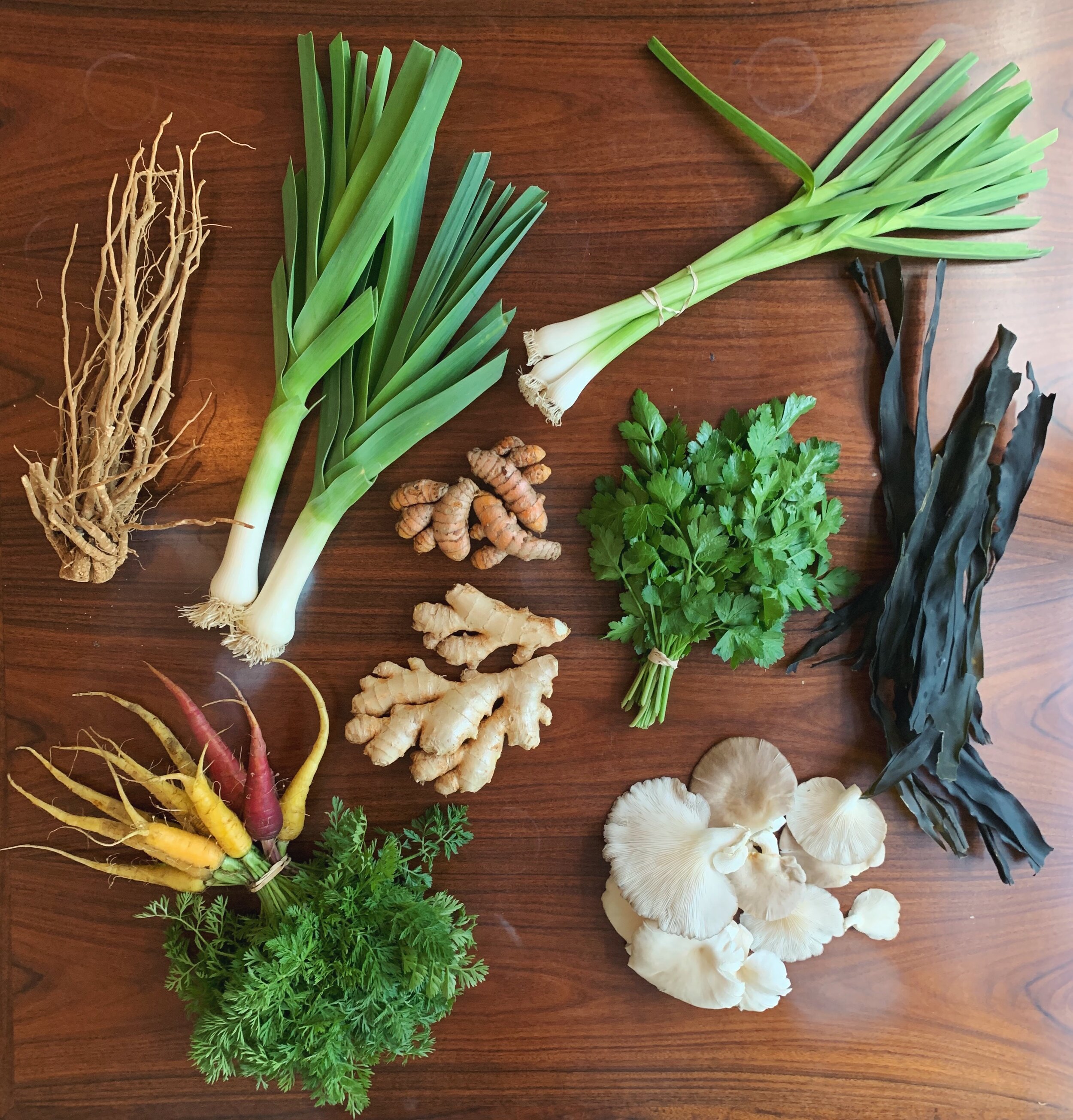The Quarantine Guide to 24-hour Bone Broth
Slow-cooked broth has been used as a traditional folk remedy for supporting recovery from the common cold, flu, pneumonia, and other infectious diseases for thousands of years. Various components of broth, especially when slow cooked from pasture raised bones, appear to boost, balance and modulate the immune system. Cartilage has been extensively studied for its immunoprotective qualities, notably its ability to aid our body in building a strong defense against unwelcome microbes. Beyond its myriad of health benefits, there is little more comforting during uncertain times like these than the warmth of a savory cup of broth.
There are many consequential ideologies that any home cook or chef will bring with them to the grave: to salt a pot of beans before or after, the sacrilege or convenience of emulsifying aioli with blades rather than the elbow grease of a whisk, to cook with olive oil or to avoid it like the plague, to roast or not to roast your bones before making broth! Truth be told, I never roast my bones - nor do I clarify or skim or do anything aside from throw my ingredients in a big pot and let time do its thing. It is a very lazy approach but does the job well.
The only thing I truly am dogmatic about is the quality of the ingredients that find their way into the pot. Seek out the best bones you can find, preferably from chickens raised on pasture and better yet from a farm nearby. Chicken feet are the unsung hero of this recipe, they make for a rich, gelatinous and deeply nutritious broth. Many poultry farmers sell chicken feet for cheap, all you have to do is kindly ask! I add kombu seaweed and shiitake mushrooms to fortify the broth with deep umami flavor and a wide array of health promoting minerals. The aromatics used are quite forgiving; any ratio of alliums and herbs you have on hand will work. Use the broth unseasoned for any recipe that calls for chicken stock, or season per the instructions below for a craveable mug ready to sip and savor.
Ingredients
For Bone Broth, Yields roughly 8 quarts
2.5 pounds of pasture raised chicken bones (feet, necks, wings and carcasses)
8-10 quarts filtered water
1 onion, roughly chopped
1 whole head garlic, halved at the equator
1 bunch parsley*
1 leek, roughly chopped
2 carrots, roughly chopped
2 stems celery, roughly chopped
2 thumb sized pieces fresh ginger, roughly chopped
1 thumb sized piece fresh turmeric, roughly chopped
2 pieces kombu
A handful of dried shiitake mushrooms
1 tsp whole black peppercorn
Coconut oil or ghee
Sea salt
A splash of apple cider vinegar
To Season:
Coconut Milk
Soy sauce or tamari
Silk chili, chili flakes, or cayenne to finish
Directions
Place your largest stock pot on the stove and turn heat to medium. Add a scant tablespoon of coconut oil or ghee to coat the bottom of the pot. Add onion, garlic, leeks, and carrots and saute until everything starts to brown. This encourages the vegetables to surrender their sweetness, developing a lovely caramelized undertone. Add the bones to the pot and stir, cooking for another minute or two.
Add a quart of water to deglaze the pot, stirring to make sure nothing burns or sticks to the bottom. Add celery, parsley, kombu, mushrooms, peppercorns, ginger, turmeric and a splash of apple cider vinegar and cover with 8-9 more quarts of water.
Bring to a boil, then cover and reduce heat to the lowest setting possible. Cook low and slow for up to 24 hours*, adding more water if necessary to keep the bones covered.
When complete, take off the heat and let cool till manageable. Strain out solids and compost. Season with salt while the broth is still warm. Taste as you season, and add enough salt for all of the flavors to come together nicely.
This next step is optional but renders a truly craveable mugful. Season your broth with coconut milk and soy sauce to your liking. The final product should be rich and aromatic. Finish with a pinch of chili to serve.
Notes
Picked off all of the leaves from your parsley and left with the stems? Chopped an onion and don’t want to discard the skins? Are those carrots you bought last week on their last breath in the back of your fridge? Keep a big resealable bag in your freezer and collect these odds and ends for later use. When ready to make your broth, you’ll have a stockpile of valuable aromatics waiting for you in the freezer.
The longer you cook your broth, the more developed and complex the flavor will be. Slow cooking broth for an extended period of time ensures you are coaxing out as much collagen from the bones as possible. I aim for 24 hours, but 8 hours is plenty if you are pressed for time.
Sources
For pasture raised chicken bones - White Oak Pastures
For sea salt - Jacobsen Sea Salt Co.
For sustainably harvested kombu - Salt Point Seaweed and Ironbound Island Seaweed
For black peppercorn and silk chili - Burlap and Barrel
About the Author
Vilda Gonzalez is the Food Editor at The Thirlby, an avid home cook, and studying to become a holistic nutritionist. She is the founder and chef of Sol-Eir, an ongoing series of alchemized food and beverage experiences. Her mission is to rewire our collective relationship to what eating well truly means; with the highest regard of respect for our body, our community, and our earth. She believes that food should be delicious, flavorful, and indulgent, but it should also be deeply nourishing, regenerative, and inherently healthful. Vilda also works with individuals to strengthen their personal relationships with food through means of intuitive cooking and connection.




